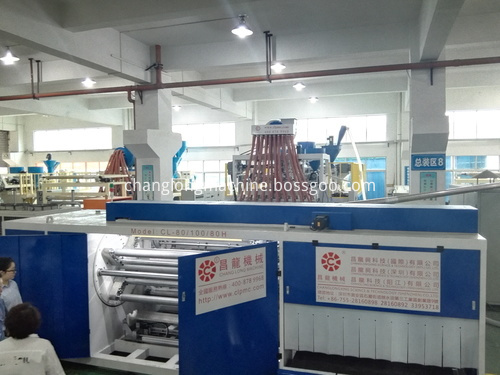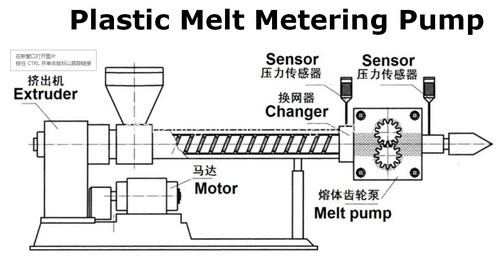Machine Pictures:
CL-80/100/80H-2000MM
CL-80/100/80H-1500MM
Featurers of Model CL-80/100/80H-1500mm
1.Strong Double Layer Vacuum Box Device
Strong Double Layer Vacuum Box Device helps absorb the hot air between film and cooling roller,which makes the film be more closed and tightly to the cooling roller thus enhance the cooling effect when the machine is running in high speed.
2. High Quality and Updated Advanced Cooling System
The cooling roller's diameter is 1000mm with bi-directional loop design and helix runner inside.The high-precision steel is adopted to ensure stable temperature on roller surface.
3.Melting Pump--Plastic melt metering pump is more and more important in extrusion process, especially in high-end products industries, such as high quality sheets, pipes, BOPP, optical cable.Installing the melt metering pump in the cast stretch film unit can make the machine produce constantly and efficiency. The pump can improve the product quality, stable the production process and decrease the energy consumption.
4.Four Air Shaft Roll Changers Device
One roll change takes only 30 seconds and this system can help produce small hand roll online when the machine is running in high speed.And so there is no need to install a Rewinding Machine to rewind,which helps save a lot of time, cost and labor.
Plastic melt metering pump is more and more important in extrusion process, especially in high-end products industries, such as high quality sheets, pipes, BOPP, optical cable.
Installing the melt metering pump in the cast stretch film unit, which can keep the production constantly and efficiency. The pump can improve the product quality, stable the production and decrease the energy consume.
The housing is made of chromium-nickel alloy or nickel-base alloy, titanium alloy. The gear is made of quenching chromium steel, other metal materials are also applicable. Bearing is made of graphite NIAG, zirconium oxide or quench tool steel.
Advantages:
FAST AND STABLE FLOW SUPPLY
Eliminated the extruder`s pulsation wave. Improve the product quality, decrease the defective rate, and decrease the waste, which can save 2% material and 25% of the unit power consumption.
STABLE AND EFFICIENCY PRESSURE CONTROL
The melt pump can provide a stable pressure, which short the discharge time obviously and make the production effectively.
INCREASE THE EXTRUDER OUTPUT AND THE MACHINE LIFE
It has been found that after install the melt pump, the max pressure wave value is the pressure after pump. Which can make the inner pressure of the extruder decrease, the melt shear strength decrease, the temperature curve gently, and restrain the temperature rising. Also the melt pump can avoid the damage to the extruder from the high pressure.
Main Technical Specification of CL-80/100/80H-1500mm
(Such as plastic film machinery.)
(1) Overall Dimensions(L*W*H): 14m*6.5*4.45
Max width of rewinding: 500mm*3
Max Rewind Diameter: ø400mm
Liner speed of machinery: 350m/min
(2)Rewind the film by combining it`s surface and core to make the film roller tightly closed and level and smooth.
(3)Remove the film roller and install the paper tube at the same time, which only takes about 25-30s and produce 2-3kg small film roller when the machine is running in high speed.
(4)Automatic edge material recycling system with on-line vacuum makes the process of rewinding more smooth, increases the fracture resistance, and decreases the limitation by liner speed.
(5)The recycling materials are extruded out from only and specific screw to stable the the extrusion system and to decrease the deviation about the weight of film.
(6) The extrusion machine is driven by coupling which stables the extrusion process and therefore stables the film output from die head.
(7)Prompt measurement to adjust the thickness and uniformity of the film easily.
High Speed Stretch Film Machine High Speed Stretch Film Machine,Automatic High Speed Stretch Film Machinery,High Speed Stretch Film Unit CHANGLONGXING SCIENCE & TECHNOLOGY (SHENZHEN) CO.,LTD , https://www.clxmachinery.com
The selection of cinnabar can be done with a small selection of shakers, a selection of chutes and manual panning. Selected operations require careful and meticulous operations, otherwise the product is difficult to meet quality requirements. Therefore, some production plants often use manual shakers or selected chutes, along with manual panning as a quality check. Selecting shakers or select chutes often require two to three sorts, and sometimes graded to meet quality requirements. Hand-washing cinnabar is a manual labor requiring high proficiency. The tool used is a circular curved sheet with a diameter of about 500-600 mm. The semi-finished cinnabar is placed in a pot, and the pot is half immersed in water and shaken repeatedly for washing. The materials are layered according to the density, and the surface gangue is washed to obtain qualified cinnabar. Skilled sand scouring workers can wash out high quality cinnabar containing 98% of mercury sulphide.
The iron removal of cinnabar is mainly to remove the iron filings that the ore enters during the crushing and grinding process. Since all of the magnetic materials are removed, permanent magnets, electromagnets or small weak magnetic separators can achieve the purpose of removing iron. However, the iron removal operation must be carried out in a state where the cinnabar material is highly loose, in order to be effective. Otherwise, the dense sand of the cinnabar crushes the iron filings, which is difficult to remove. The mercury mine in Guizhou uses the method of suspending the electromagnet above the bed surface concentrate belt of the cinnabar selection shaker, and combines the two operations of selecting and removing iron into one set of equipment. Increased productivity and streamlined processes.
After selection and removal of iron, cinnabar must be dried in time. At high temperatures, mercury can be rapidly reduced to a gaseous state. Therefore, drying cinnabar must be carried out at low temperatures, and there are various methods of drying. Small batches can be used in electric drying ovens or special electric drying beds. Generally, the temperature for drying is controlled at about 100 °C. The belt type far-infrared cinnabar dryer developed by Guizhou Mercury Mine can work continuously and adjust the drying temperature, which is suitable for mass production. Regardless of the drying method used, ventilation must be strengthened in the cinnabar drying operation area to discharge a small amount of mercury vapor generated during the drying process. Mercury vapor not only harmful to the health of operators, but also become the gold fine particles may condense genus beads of mercury into the finished product cinnabar, affect product quality.
2. Mineral processing of other mercury-containing materials (1) Mercury strontium beneficiation: Mercury strontium is an intermediate product of the pyrometallurgical process. Mercury vapors from pyrometallurgical smelting process, part of which forms fine mercury beads, settle together with dust and certain substances from the roasting process to form mercury hydrazine. The composition and properties of mercury bismuth are related to factors such as the composition of the mercury-containing materials and the smelting method. Therefore, the composition and properties of mercury bismuth in various mercury smelters vary widely. In general, mercury hydrazine is an extremely complex, fine-grained mercury composed of metallic mercury and its sulfides, sulfates, arsenic , antimony and other metal oxides, carbon black, dust and moisture. mixture. Mercury content ranges from a few percent to several tens of percent. The color is usually from gray to black. Due to the high water content, the mercury mash is muddy and most of the mercury droplets are encapsulated in the sludge medium. The phase measurement of mercury hydrazine shows that most of the mercury is present in the state of metallic mercury, a small amount of sulfide of mercury, and a very small amount of oxide of mercury.
For the treatment of mercury hydrazine, the traditional method is to wash some of the soot with water, then put it into the mercury mashing machine, add appropriate amount of lime, and mix or squeeze with manual or mechanical mixing to separate most of the metal mercury, and the residue is returned to the furnace for smelting treatment. This method treats mercury hydrazine, has high labor intensity and poor sanitary conditions. Some mercury smelters use a beneficiation process to treat mercury strontium. A common method for mercury strontium ore dressing is re-election, such as cyclones and shakers. Many domestic mercury smelters use a cyclone to treat mercury hydrazine. The mercury mash is added to the slurry, sent to the hydrocyclone by a sand pump, closed loop, and repeatedly treated. Guizhou mercury treated with boiling cyclone furnace soot mercury, Ñ„125 mm diameter cyclone, the ore concentration of 5 to 10%, inlet pressure 200 to 400 kPa (2 to 4 kg / cm 2), the process mercury 39 When mercury is present in %, the recovered metal mercury can be as high as 99%. When dealing with mercury-depleted cesium containing 0.78~2.55% mercury, the mercury removal rate is 81~93%, and the cyclone overflow contains about 0.1~0.5% mercury. The mercury enthalpy is treated by a cyclone, and the overflow cannot be discarded. Further treatment is required. The general smelting plant is initially dehydrated and then returned to the furnace for smelting. The mercury mine in Guizhou has studied the treatment of mercury hydrazine by a combination of a cyclone and a flotation machine. When the cyclone overflow contains 0.6~1% of mercury into the flotation, the sulfur nitrogen No. 9 is used as the collector , the flotation recovery rate is up to 98.93%, and the flotation tailings contains 0.012% of mercury.
(2) Beneficiation of mercury-containing polymetallic ores: Mercury-type ores are the most common mercury-containing ores of industrial value. The mercury ore symbiotic ore is economically and rationally processed through beneficiation. Mercury-mixed concentrates are usually selected by flotation, and mercury and hydrazine are separately recovered during smelting. White Silver Institute of Mining and Metallurgy mercury antimony sulfide had a place in our country, Shaanxi Province symbiotic ore experimental research conducted over the election. With lead nitrate as the activator flotation mercury, antimony, by selection of the mixed concentrate, stibnite suppressed by weight of chromium, potassium, antimony, mercury separation purposes. The ore contains 0.39% mercury and 1.55% bismuth; the mercury concentrate contains 69.08% mercury, the mercury recovery rate is 87.13%; the strontium concentrate contains 53.06%, and the strontium recovery rate is 91.58%. However, the content of synonymous minerals in the mercury concentrates and antimony concentrates after sorting is still high. Mercury concentrate contains 5.35% bismuth and bismuth concentrate contains 1.07% mercury. Comprehensive recovery is still required during smelting.
Ore lead zinc ore, copper ore and the like containing a small quantity of mercury, usually concentrated in the flotation process to concentrate the mercury, smelting, mercury recovered as a byproduct.


Beneficiation of cinnabar ore and other mercury-containing materials
1. Cinnabar ore dressing The production of cinnabar has a long history in China. By using the characteristics of large density and brittleness of cinnabar minerals, the ore is crushed, sieved, sieved, and graded through a chute, and then manually washed to obtain high quality cinnabar. This is the traditional production method of cinnabar, which is still used in some small mines. This method is simple in process and good in product quality. In stage ore crushing plant is selected from any mercury or mercury ore smelters, may be inserted into a portion of this recovered cinnabar. The mechanized production of cinnabar began in China in the late 1960s. The main equipment is a jig and a shaker. Jigs and industrial shakers can only obtain primary semi-finished products containing about 50-70% of mercury sulphide. In order to obtain high quality finished cinnabar, it needs to be finished. The finishing of cinnabar is the key to the production of cinnabar, which includes three main operations: selection, iron removal and dehydration.